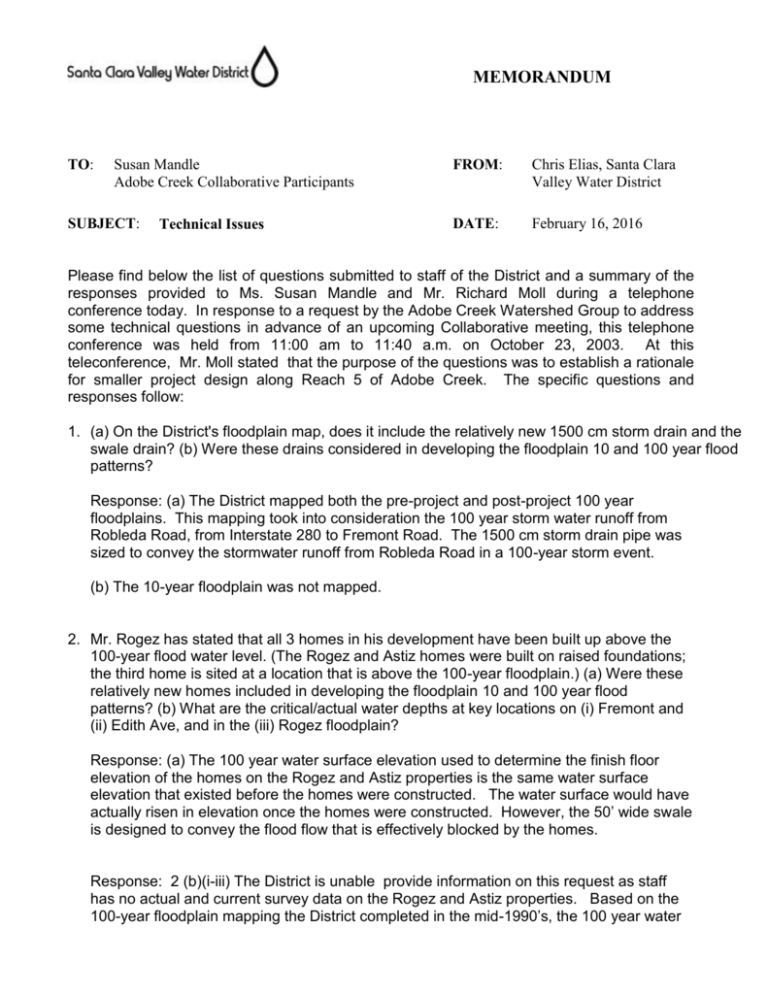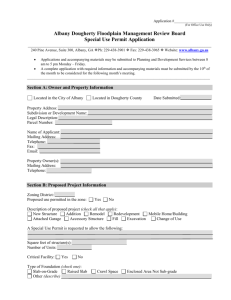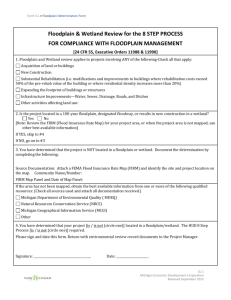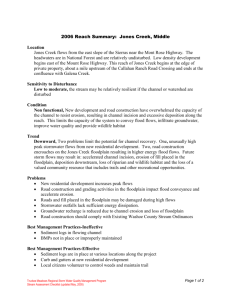memorandum - Los Altos Hills Open Space
advertisement

MEMORANDUM TO: Susan Mandle Adobe Creek Collaborative Participants SUBJECT: Technical Issues FROM: Chris Elias, Santa Clara Valley Water District DATE: February 16, 2016 Please find below the list of questions submitted to staff of the District and a summary of the responses provided to Ms. Susan Mandle and Mr. Richard Moll during a telephone conference today. In response to a request by the Adobe Creek Watershed Group to address some technical questions in advance of an upcoming Collaborative meeting, this telephone conference was held from 11:00 am to 11:40 a.m. on October 23, 2003. At this teleconference, Mr. Moll stated that the purpose of the questions was to establish a rationale for smaller project design along Reach 5 of Adobe Creek. The specific questions and responses follow: 1. (a) On the District's floodplain map, does it include the relatively new 1500 cm storm drain and the swale drain? (b) Were these drains considered in developing the floodplain 10 and 100 year flood patterns? Response: (a) The District mapped both the pre-project and post-project 100 year floodplains. This mapping took into consideration the 100 year storm water runoff from Robleda Road, from Interstate 280 to Fremont Road. The 1500 cm storm drain pipe was sized to convey the stormwater runoff from Robleda Road in a 100-year storm event. (b) The 10-year floodplain was not mapped. 2. Mr. Rogez has stated that all 3 homes in his development have been built up above the 100-year flood water level. (The Rogez and Astiz homes were built on raised foundations; the third home is sited at a location that is above the 100-year floodplain.) (a) Were these relatively new homes included in developing the floodplain 10 and 100 year flood patterns? (b) What are the critical/actual water depths at key locations on (i) Fremont and (ii) Edith Ave, and in the (iii) Rogez floodplain? Response: (a) The 100 year water surface elevation used to determine the finish floor elevation of the homes on the Rogez and Astiz properties is the same water surface elevation that existed before the homes were constructed. The water surface would have actually risen in elevation once the homes were constructed. However, the 50’ wide swale is designed to convey the flood flow that is effectively blocked by the homes. Response: 2 (b)(i-iii) The District is unable provide information on this request as staff has no actual and current survey data on the Rogez and Astiz properties. Based on the 100-year floodplain mapping the District completed in the mid-1990’s, the 100 year water Susan Mandle Richard Moll Adobe Creek Collaborative Participants February 16, 2016 surface elevation on the Rogez property would have been approximately 1’-1.5’ above the ground elevation. However, since this mapping was completed, the ground elevations across the Rogez property have changed. To determine the current estimated depth of water across the Rogez property due to a 100-year storm event, the Rogez property would need to be re-surveyed. 3. What is the District's schedule in starting action on critical design review issues, such as a.) Confirming the design flow rates between El Camino and Foothill College b.) Modeling the water flow out of channel and through Edith Park c.) Reviewing the flow data down Robleda and into Reach 5 below Edith Ave Response: (a) There are currently no plans to review the design flood flows identified in the Adobe Creek Watershed Planning Study. District staff recommends this issue be brought up before the Collaborative for discussion and decision. (b) The District completed pre-project floodplain mapping which shows the existing flow patterns. (c ) There are currently no plans to review the runoff flow from Robleda Road. 4. What are the critical/actual water depths at key locations on Fremont and Edith Ave, and in the Rogez floodplain? Response: Please see response to Question #2 above. 5. What is the District's schedule in starting action on critical design review issues, such as: a) Confirming the design flow rates between El Camino and Foothill College (Reach 5 used 2740 cfs?) b) Modeling the water flow out of channel and through Edith Park c) Reviewing the flow data down Robleda and into Reach 5 below Edith Ave d) Identifying CRITICAL and KEY design items with options and alternate design impacts (for example, the height of the concrete wall at Millars) Response: a), b) and c) – Please see responses to Question #3 above. (d) District staff was unable to provide specific response as the question was not clearly understood. However, District staff recommended this issue be brought up for group discussion during the Collaborative meetings. Page 2 of 3 Susan Mandle Richard Moll Adobe Creek Collaborative Participants February 16, 2016 6. One question that keeps coming up is identification of the technical reason that caused the District's design to change so much between the planning phase design with a 2' upper bench drop to a 6' drop in the detailed design phase. Several people think it is related to an amendment document that changed the design concept from recognizing the Edith Park and Rogez floodplains to a concept that artificially imposed a non-existing straight wall at the upper end of Edith Park to forcibly model all the water remaining in the creek bed. We feel that this was a significant detriment to a realistic design, and would like to avoid this problem. We feel that acknowledging the actual floodplain, and it's influence on the flow patterns, will reduce the design flow requirement under Edith Bridge, and ameliorate the construction concept. We are trying to locate and identify this Amendment Document. Do you have any information, or perhaps Scott Wilson? Response: Based on the Planning Study and the project proposed by the District as recently as April 2003, here is some useful information: A design flow of 2,700 cubic feet per second was used in the hydraulic analysis completed to develop the conceptual design presented in the Planning Study. This is the same flowrate that was used in the hydraulic analyses completed to develop the detailed design. Both analyses assume that the 100 year flood flow is contained within the channel just upstream of Edith bridge. As noted, during design a change was made to the difference in elevation between the floodway bench and the top of bank on the Los Altos Hills side. The Planning Study shows the floodway bench to be 5’ below the top of bank. The design shows the floodway bench to be 5’-8.5’ below the top of bank. The channel invert was lowered approximately 0.5’ during the design, which contributes to the 3.5’ difference. Based on survey work completed in the late 1990’s, the ground on the Rogez property was raised sometime following completion of the Planning Study. The District attributes this placement of fill on the Rogez property in the interim between the completion of the Planning Study and completion of design as the primary reason why the drop from top of bank to floodway bench increased significantly. The District has not surveyed the Rogez property to confirm these numbers. Walls on both sides of the creek: - These are needed to carry out effective modeling to show the full impact of the flow. This project modeling differs from the floodplain modeling which does not use these “walls”. Mr. Moll’s response was that he believes that modeling of the current situation, accurately reflecting the home siting and changed elevations in the Rogez floodplain, is vitally necessary to evaluate the return of these floodwaters into Adobe Creek. Page 3 of 3







